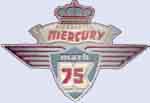Seems like this topic is all over the map on some websites new and old and still the argument carries on. So far there are some pretty close answers linked to previous studies on 2 stroke tunning. Jennings studied loop engines and came up with some plausible positions on so many things the guy is remarkable in his time.
On the Deflector side of tunning the leaders were very much Quincy Welding in terms of getting Mercs to breathe and exhaust. No other firm did so much with the limitations imposed by Deflector technology as they did. They also realized the shortcomings of Merc's crankcases and did some profound work as in stuffing 30Hs crankcase tunnels. With 55Hs and 44s they added 3rd ports that at higher rpms created ram that worked but they never went into carb development with a real tunned velocity stack to ram the 3rd port for the duration it was available.
Quincy also realized that the higher rpms you pushed a deflector the more heat soaked the pistons got plus the efficiency drops off real fast as the technology reached its outer limits of its effective rpm as a pumping chamber or in other words the higher the rpm the more inefficient the engine became plus the heat soak that made them melt down crowns so fequently. Deflectors by their nature are more effective than a looper but you have to keep the revs down to develop best horsepower and torque.
Quincy saw real fast with the Anzanis roaring out there that a loop engine kept getting more efficient and powerful as the revs go up. British Anzanis are 3rd port and beyond loop type engines. With seeing the light that mean't you either changed your racing technology or died and Quincy dumped the Deflector Merc so fast some engines that came into the shop never left but a Flathead replacement was on its way to sit on that tower housing or a complete motor by all accounts when the transition happened. These days you see little loopers pulling 20,000rpm pulling power to displacement no deflector can even come close to. A lot of that is the engine but another big factor is the expansion chambered exhausts deflector engines are problematic to engineer for.
Still there is some room for the 3rd port deflector in Merc 44 FE gassers but like all changes its a little bit at a time and still there is the pesky port and that velocity stack to perfect that will vary with each different deflector engine configured until that ultimate power is attained. Easy said but a lot of work to it that would need to be done. Quincy Welding had it right but what do you do when small loop engines come on the scene to twist everyones necks?


 Thanks:
Thanks:  Likes:
Likes: 
 Reply With Quote
Reply With Quote




Bookmarks